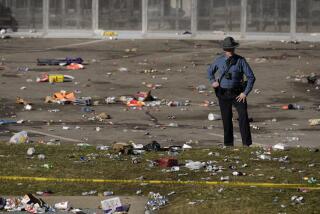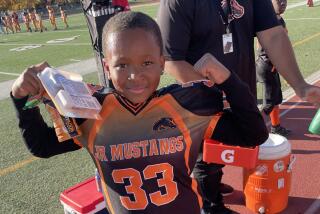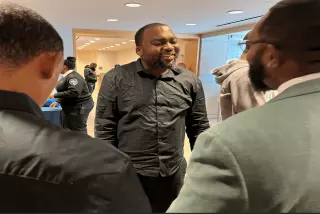Trauma Team Reacts to Wounded Toddler
- Share via
Dr. Debra Stafford, a new resident at Martin Luther King Jr./Drew Medical Center, said she was surprised when she answered the trauma team call to the emergency room and discovered that the patient with a gunshot wound was a toddler.
“This child was so young,” said Stafford, 24, who is fresh from Brown University Medical School and was among the physicians who treated 2-year-old Jonathon Fabian of Lynwood. “He was so scared. He just cried the whole time for his mother.”
Dr. Frank Kennedy, a trauma surgeon who is in his seventh year of post-medical school training, is beyond surprise, but not beyond anger. “These are completely, completely innocent people . . . and they can’t defend themselves,” Kennedy said.
Since arriving at King in April, Kennedy said he has treated a dozen children 14 and under for gunshot wounds, including two 14-year-old girls last weekend. One of them died of a bullet wound in the heart. Gunshot victims at King are noticeably younger than Kennedy saw in his six years of surgical residency at County-USC Medical Center.
Jonathon, is the youngest gunshot victim in the staff’s recent memory, though there have been younger victims of stray gang bullets in the city. Jonathon was shot as he played outside his Platt Avenue home Tuesday evening. He has since undergone exploratory abdominal surgery and was in stable condition, authorities said Thursday.
The bullet did not penetrate the abdominal cavity and doctors said the toddler is expected to recover.
The King medical center, just south of Watts, sees more trauma patients than most hospitals. In fact, there are so many victims with gunshot wounds that Army surgeons are now being trained there.
As the victims increasingly are younger, the job of the physicians who must deal with their injuries becomes increasingly difficult.
These doctors say they feel shock and anger but must remain dispassionate.
Imani Williams, a physician’s assistant in the surgery department, said the hospital’s pediatric ward is probably like no other.
“It’s amazing,” she said. “If you go up to the pediatric ward a lot of the patients are shooting victims.”
Still, during the heat of trauma treatment, team members concentrate on their much-practiced drill, though they say they never get used to the carnage.
“You can’t get caught up in, ‘That’s a poor little baby’ ” Williams said.
Williams said she recalls one preschool victim of a gang-related shooting, a 4-year-old girl, who survived her injuries. Both the girl’s parents were active gang members, Williams said.
But for the most part, trauma team members do not know--or care--if the bleeding bodies they are laboring to save belong to innocent bystanders, or not-so-innocent gangbangers.
“I look at it this way,” Kennedy said. “No one deserves to be shot and get killed . . . even if they are a gangster.”
“There’s no question some of the guys we fix up go out and shoot people . . . but a small percentage,” he said.
Kennedy remembered once asking a wounded youth, “What happened?”
The teen-ager said he was shot by police because he didn’t obey their command.
The doctor said he was feeling sympathetic until further inquiry revealed that the unheeded command was, “Drop your weapon.”
Though all the wounded get the same treatment in the trauma room, that does not mean doctors are blind to the realities of gang warfare.
Kennedy said he had two known gang members with bullet wounds in the same room when he was doing his residency at County-USC. The doctor inquired about the pair’s gang affiliation to prevent mayhem on the ward had the two belonged to warring groups.
The two roommates were totally different, he said. One was timid and sheepish. The other was the center of attention with frequent visits from his “homeboys.”
“It was like he was a hero,” said Kennedy.
The “hero” didn’t make it to his post-hospital visit. Kennedy said he got a call from the boy’s mother saying he had been shot again and was in the emergency room.
It is not unusual to see gunshot victims back for the second time, or in the case of one man, six times.
Kennedy explained that the doctors at King place a priority on making sure bullets are removed from gunshot victims--so they can quickly tell next time if the bullet that turns up on an X-ray is new or from a previous gunshot wound.
Stafford, the newest member of the trauma team, had never treated a gunshot wound until about three months ago. At King, she will get more than her share. She judges her own reaction to her job by the cases she shares with her family--usually the patients who die and the ones who are young. Stafford said she told them about Jonathon Fabian.
More to Read
Sign up for Essential California
The most important California stories and recommendations in your inbox every morning.
You may occasionally receive promotional content from the Los Angeles Times.













